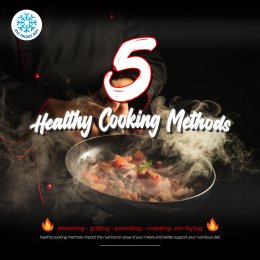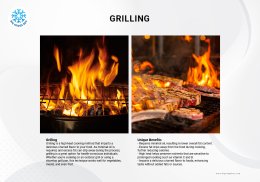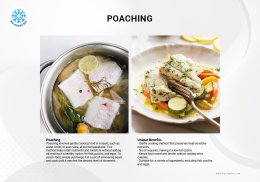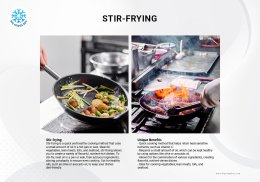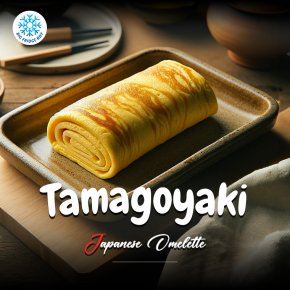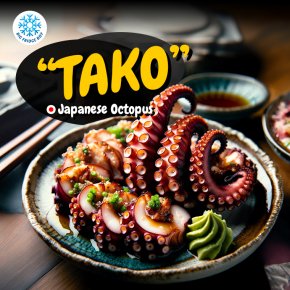"5 Healthy Cooking Methods" For A Nutritious Diet
Last updated: 10 May 2023 | 1321 Views |

When following a diet or striving for healthy eating habits, it's essential to not only choose the right ingredients but also to cook your food in a way that preserves nutrients and minimizes unhealthy fats. By incorporating five healthy cooking methods – steaming, grilling, poaching, roasting, and stir-frying – into your daily routine, you can significantly impact the nutritional value of your meals and better support your nutritious diet, ultimately promoting overall well-being without sacrificing flavor.

Steaming
Steaming is a gentle, oil-free cooking method that relies on hot water vapor to cook food. This technique is excellent for retaining nutrients, as it prevents them from being lost in the cooking water. Ideal for vegetables, fish, and lean meats, steaming is a versatile and healthy way to prepare your meals. To steam food, simply place it in a steamer basket over a pot of boiling water, cover, and allow the steam to cook your ingredients.
- Retains most nutrients, especially water-soluble vitamins, which can be lost in other cooking methods.
- Requires no oil, making it an ideal low-fat option.
- Keeps food moist and tender without adding extra calories.
- Gentle cooking method, suitable for a variety of ingredients, including vegetables, fish, and lean meats.
Steaming typically occurs at temperatures around 212°F (100°C), which is the boiling point of water at sea level. The food is cooked by the hot steam generated from boiling water, without direct contact with the water itself.
Steaming preserves most of the nutrients in food because it doesn't require submerging the ingredients in water or exposing them to high temperatures. Studies have shown that steaming is one of the best cooking methods for retaining water-soluble vitamins, such as vitamin C and B vitamins, which are often lost in other cooking techniques (Palermo et al., 2014).

Grilling
Grilling is a high-heat cooking method that imparts a delicious charred flavor to your food. As minimal oil is required, and excess fat can drip away during the process, grilling is a great option for health-conscious individuals. Whether you're cooking on an outdoor grill or using a stovetop grill pan, this technique works well for vegetables, meats, and even fruit.
- Requires minimal oil, resulting in lower overall fat content.
- Excess fat drips away from the food during cooking, further reducing calories.
- High heat helps preserve nutrients that are sensitive to prolonged cooking such as vitamin C and B.
- Imparts a delicious charred flavor to foods, enhancing taste without added fats or sauces.
Grilling temperatures can range from 350°F to 550°F (175°C to 290°C) or even higher, depending on the type of grill and the desired level of doneness. For example, low and slow grilling can be done around 250°F (120°C) for tender, slow-cooked meats, while high-heat grilling for searing and caramelization usually occurs at 400°F (200°C) or higher.
Grilling cooks food quickly at high heat, which can help preserve nutrients that are sensitive to heat and cooking duration. However, it's essential to be cautious when grilling meat at high temperatures, as this can lead to the formation of potentially harmful compounds, such as heterocyclic amines (HCAs) and polycyclic aromatic hydrocarbons (PAHs). Marinating meat before grilling and avoiding charring can help reduce the formation of these compounds (Sinha et al., 1998).

Poaching
Poaching involves gently cooking food in a liquid, such as water, broth, or even wine, at low temperatures. This method helps retain nutrients and moisture without adding oil, making it a healthy option for fish, poultry, and eggs. To poach food, simply submerge it in a pot of simmering liquid and cook until it reaches the desired level of doneness.
- Gentle cooking method that preserves heat-sensitive nutrients.
- No oil required, making it a low-fat option.
- Keeps food moist and tender without adding extra calories.
- Suitable for a variety of ingredients, including fish, poultry, and eggs.
Poaching is done at lower temperatures than boiling, generally between 160°F and 180°F (70°C to 82°C). This gentle cooking method ensures that the food remains tender and moist without overcooking or breaking apart.
Poaching involves cooking food at a lower temperature than boiling, which can help preserve heat-sensitive nutrients. Studies have shown that poaching can retain more omega-3 fatty acids in fish compared to other cooking methods like frying or baking (Boselli et al., 2009).

Roasting
Roasting food in the oven at high temperatures allows it to cook in its own juices, often resulting in a flavorful and tender dish. With little to no added fat required, roasting is an excellent choice for cooking vegetables, lean meats, and poultry. To roast, place your ingredients on a baking sheet or roasting pan, and cook them in a preheated oven until they are done to your preference.
- Requires little to no added fat, making it a healthier option compared to frying or sautéing.
- Cooks food in its own juices, preserving natural flavors and nutrients.
- High-temperature cooking develops complex flavors and aromas through the Maillard reaction.
- Versatile method, suitable for vegetables, lean meats, and poultry.
Roasting temperatures can vary greatly depending on the type of food and the desired outcome. Generally, roasting occurs at temperatures between 325°F and 450°F (163°C to 232°C).
- Lower temperatures (around 325°F or 163°C) are used for slow-roasting larger cuts of meat.
- Higher temperatures (400°F or 200°C and above) are used for quickly cooking smaller items like vegetables or for searing the outside of a roast.
Roasting at high temperatures can cause the Maillard reaction, which is responsible for the development of complex flavors and aromas. However, this reaction can also generate advanced glycation end products (AGEs), which have been linked to inflammation and chronic diseases (Uribarri et al., 2010). Roasting at lower temperatures and monitoring cooking duration can help minimize AGEs formation.

Stir-frying
Stir-frying is a quick and healthy cooking method that uses a small amount of oil in a hot pan or wok. Ideal for vegetables, lean meats, tofu, and seafood, stir-frying allows you to create a variety of flavorful, nutrient-rich dishes. To stir-fry, heat oil in a pan or wok, then add your ingredients, stirring constantly to ensure even cooking. Opt for healthy oils, such as olive or avocado oil, to keep your dishes diet-friendly.
- Quick cooking method that helps retain heat-sensitive nutrients, such as vitamin C.
- Requires a small amount of oil, which can be kept healthy by using options like olive or avocado oil.
- Allows for the combination of various ingredients, creating flavorful, nutrient-dense dishes.
- Ideal for cooking vegetables, lean meats, tofu, and seafood.
Stir-frying is done at high temperatures, typically between 350°F and 400°F (175°C to 200°C). The high heat allows for quick cooking, which helps retain nutrients and minimizes the use of oil. It's crucial to keep the food moving in the pan or wok to prevent burning and ensure even cooking.
Stir-frying is a quick cooking method that can help retain nutrients in vegetables, such as vitamin C, which can be degraded by heat and prolonged cooking times (Zhang & Hamauzu, 2004). However, it's essential to use a minimal amount of healthy oil to avoid adding excessive calories and unhealthy fats to your diet.
Incorporating the five healthy cooking methods – steaming, grilling, poaching, roasting, and stir-frying – into your meal preparation routine can significantly impact your overall well-being and support a nutritious diet. By choosing techniques that preserve nutrients and limit unhealthy fats, you can enjoy delicious, healthful meals without compromising on flavor.
In conclusion, understanding the different effects of cooking methods on nutrient retention and the formation of potentially harmful compounds is crucial for optimizing the health benefits of your diet. By embracing these healthy cooking techniques and making informed choices about how to prepare your food, you can enhance the nutritional value of your meals and promote a healthier lifestyle.
